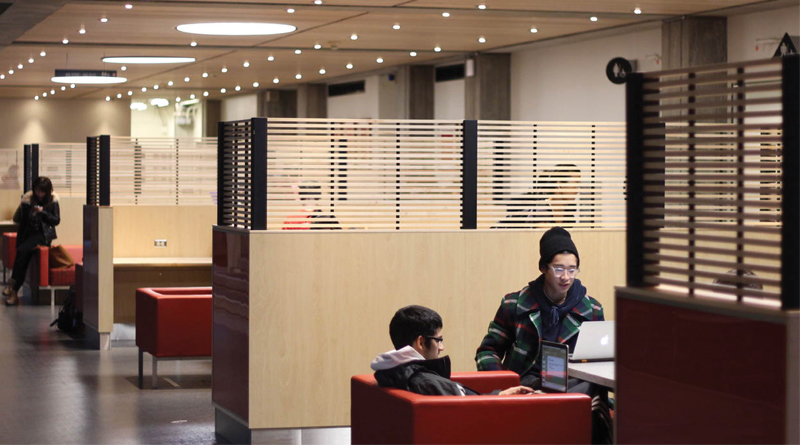Designing for Safety: The Next Step
By Celine Larkin
Campus safety could not be a timelier topic, from elementary school and high school to college and university campuses. Larger issues like gun control will take time to address as students arrive on college campuses. Underlying and growing in parallel on our campuses is stress among students that have seen the unthinkable happen time and time again, continuing to feel unsafe and needing safety in every way. They crave clarity, predictability and peace. They need well-being.

Last year, I covered ways to improve safety through design strategies like Crime Prevention through Environmental Design (CPTED). But we can expand this toolkit in other ways, taking a view on campus safety of broader dimensions. Studies dating back to 2001 show well-being design strategies reduced mental fatigue, hostility and outbursts of anger. In one study — titled “Environment and Crime in the Inner City: Does Vegetation Reduce Crime?” — greener buildings resulted in 52 percent fewer felonies, with 7 to 8 percent linked to increased access to nature, which is also strongly tied to increased calm, ability to focus, reduced absence and greatly improved school retention rates. Stress inhibits situational awareness, the conscious observance of one’s surroundings that alerts to health and safety threats, and we miss leakage, the term for the hints disturbed people leave that forewarn catastrophic behavior.
Environmental Stressors
Environmental stressors affect our bodies without our knowledge or volition, constantly affecting our well-being. New understanding of our physiological and psychological relationship with our environment applied to campus planning, design and architecture can improve daily experience, well-being and support individual resiliency. At our disposal are:
• Experience Design, the process of identifying, designing, delivering and maintaining meaningful experiences over time;
• Biophilic Design, the process of design that stems from understanding the inherent human inclination to affiliate with nature; and
• Multi-Sensory Design, the process of design based on the application of scientific study of sensory perception and its effect on well-being.
These strategies contribute to the Settings Approach to design.
Settings Approach
The term Settings Approach refers to health and well-being stemming from the settings of daily life. As discussed by Dr. Mark Dooris, leader of the United Kingdom’s Healthy Universities Model and Framework Project and a founding contributor to the Okanagan Charter, this holistic model is concerned with making the actual places where people spend their time — the physical reality of our campuses — supportive of well-being.
The Settings Approach is at the core of the Okanagan Charter. It was created in 2015 by more than 380 researchers, practitioners, administrators, students and policy makers from 45 countries, including representatives from the World Health Organization; Pan American Health Organization; and the United Nations Educational, Scientific and Cultural Organization on the territory of the Okanagan Nation in Kelowna, Canada. The charter is being adopted by increasing numbers of institutions nationally, setting a commitment and process for well-being on all campuses.
The charter includes two Calls to Action — embed health into all aspects of campus culture, across administration, operations and academic mandates, and lead health promotion action and collaboration locally and globally. Four sub-goals pertain particularly to physical planning, design and maintenance of campus facilities, landscape and infrastructure.
• Include health, well-being and sustainability in all planning and decision-making of campuses and communities, with practices integrated and coordinated across all campus programs.
• Identify opportunities to study and support health and well-being as well as sustainability and resilience, in built and natural academic and learning environments.
• Proactively and intentionally create empowered, connected and resilient campus communities.
• Use cross-cutting approaches to embed understanding and commitment to health, well-being and sustainability in every aspect of campus life, thereby providing both healthful experience and habits that students will carry into life after graduation.
Two of the charter’s key principles directly address school construction and infrastructure: a focus on settings and whole system approaches and emphasis on comprehensive, campus-wide approaches to development and implementation plans for campus communities.
What More Can We Do?
First and foremost, central to the charter is defying silos and working with campus colleagues who may have only participated peripherally or incidentally in the development of campus facilities and master plans in the past. The National Association of Student Personnel Administrators (NASPA) has been at the forefront of educating student life administrators to the Settings Approach and aspects of campus planning and design that affect well-being. Get to know the student life administrators at your institution. Engage them in the development of new projects beyond the cursory initial focus groups. They want to be your partner and will be there to monitor success through the life of the facility.
Don’t wait for a major project to begin. A great success story from Simon Fraser University (SFU) in Vancouver, an early adopter of the Okanagan Charter, started with a simple renovation of a tired study area completed in-house by Facilities Services. Together, Rosie Dhaliwal, acting associate director of Health Promotion, and Marcos Olindan from Facilities Services began to expand the typical process, engaging students in deeper, more meaningful and continuous ways and focusing on features that improve the social, mental and physical health and well-being of space users.
The renewed area was so successful that the process was repeated many times in other areas throughout SFU’s Academic Quadrangle. Principles for Enhancing Well-Being Through Physical Spaces at SFU, guidelines developed from these projects, are now part of SFU’s Healthy Campus Community initiative, and are used in tandem with existing design procedures and standards such as WELL Building Standard, Whole Building Design Guide, LEED and CPTED.
Students are standing up, demanding greater response to campus safety. We are all on a learning curve, but with a more comprehensive attitude, we have tools and strategies available to meet this challenge.
Celine Larkin, AIA, LEED AP, is an architect, urban designer and campus planner with a passion for improving educational settings, currently focused on research into Gen Z and strategies that increase well-being and learning in all built environments. Formerly head of Urban Design/Master Planning at HGA Architects, Engineers + Planners and Gensler Los Angeles, she now consults internationally, based in Doha, Qatar.

